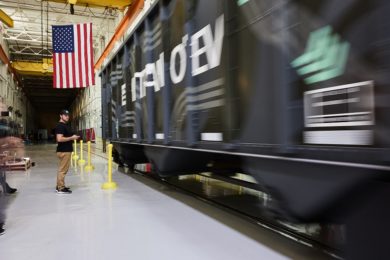With Ausdrill having recently added a Boart Longyear LF160 drill rig and FL262 FREEDOM™ LOADER combination to its diamond drilling fleet in Australia, IM caught up with Eric Gobbert, Senior Operations Manager, Exploration, to find out more about the company’s ‘hands-off-steel’ initiatives.
The newest coring rig – capable of pulling a 4.5 m sample – comes with a tilting top drive head to simplify rod handling, a foot clamp and braking device, and visible wireline. This is the second LF160 in Ausdrill’s portfolio, and a third rig is on the way. Meanwhile, the company is actively exploring a similar system capable of offering 6 m samples.
One rig is currently active at a Queensland coal operation, with the second at a nickel operation in the Goldfields of Western Australia. The third is expected to go to the Pilbara iron ore sector.
It is the combination of the LF160 with the FL262 FREEDOM LOADER that is bringing safety benefits to Ausdrill and its customers.
With totally hands-free rod handling, the combined rig and loader require no intervention from the driller’s assistant to trip in and align the rods or connect to the top drive head – thus offering greater freedom to drill by reducing the risk of hand and back injuries while handling rods. This freedom of movement comes as a result of the FREEDOM LOADER’s remote-control panel, which allows drillers to move to – and work from – a safer location away from the risks of moving rods.
“It’s a good innovation and has enabled us to provide a much-needed solution,” Gobbert said.
Ausdrill, a Perenti company, was encouraged to adopt this new diamond drilling technology as part of its own commitment to developing the mines of the future in partnership with clients. “Most companies have technology roadmaps with a strong safety vision. These roadmaps outline the future expectations for increased safety of exploration drill rigs,” Gobbert told IM.
Exploration drilling is an obvious place for Tier 1 miners to look to for safety improvements. A manual and repetitive job, traditional diamond drilling comes with many injuries as a result of drillers and offsiders removing and inserting heavy drill rods into the rigs. While automating part of the exploration drilling process may not provide the same financial payback as automating haul trucks or blasthole rigs, it does significantly reduce risk to personnel.
Gobbert agrees: “If you look at the drill inserts and the ongoing safety risks associated with being a driller’s offsider, or drilling in general, reducing the whole hands-on steel process and going down the automated or autonomous path makes sense.”
It is improving safety that is the real aim of leveraging such technology, according to Gobbert.
“De-risking the manual handling component is the real winning aspect of this,” he said. “We all want to achieve our business aims, but more importantly ensure our staff and our client’s staff are safe in the process.”
And, by reducing these risks, companies are ensuring continuity of operations, with personnel less likely to obtain the injuries that so often come with diamond drilling.
“Safety has always been at the centre of our technological drive – we understand that a safe project is a successful project,” Gobbert said.
This is not Ausdrill’s first foray into hands-off-steel diamond drilling. Drill Rigs Australia, an Ausdrill subsidiary up until July, previously engineered a similar style rod presenting system on one of its rigs at a Tier 1 client’s operation. Gobbert says the rig is still successfully operating – a full five years on.
“Ausdrill has a 30+ year history of designing and customising fleet to suit the needs of our clients and the swiftly-evolving market,” Gobbert says. “Today, we work in partnership with our clients, OEMs and third-party tech service providers to bring a bespoke combination of fleet and equipment, geared specifically to the needs of each project. Our project success and notable safety records showcase just how well we are delivering on our intentions, and tracking along our roadmap.”










